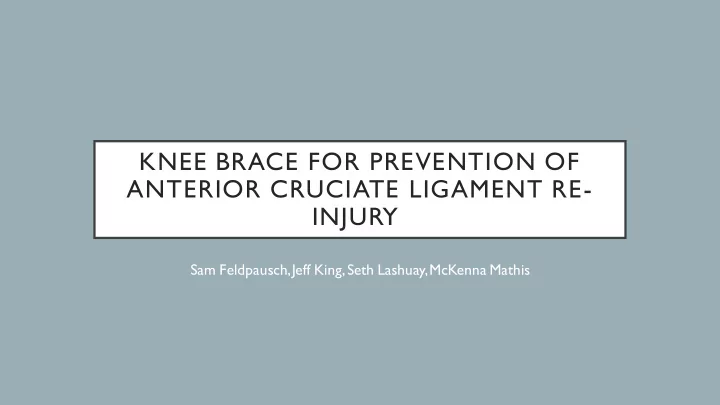

KNEE BRACE FOR PREVENTION OF ANTERIOR CRUCIATE LIGAMENT RE- INJURY Sam Feldpausch, Jeff King, Seth Lashuay, McKenna Mathis
PROBLEM/PURPOSE Problem : Re-injury post ACL reconstruction when athletes return to sport Purpose : To evaluate the effectiveness of a functional knee brace in preventing reinjury post ACL reconstruction surgery in comparison to non-bracing methods. Hypothesis : There will be a decrease in the re-injury rate of repaired ACL's in subjects that wear a functional knee brace compared to those who do not wear a knee brace.
DEFINITIONS Re-injury • Complete or partial tear of the previously repaired anterior cruciate ligament Functional Knee Brace • "Intended to stabilize knees during rotational and anteroposterior forces, used in adjunct to muscular rehabilitation for graft protection following ACL reconstruction." 1
EFFECTS OF A FUNCTIONAL KNEE BRACE FOR ACL INSUFFICIENCY DURING TREADMILL RUNNING • This study looked at the effects of a functional knee bracing for ACL insufficiency (ACLI) on physiological and perceptual parameters during treadmill running for 13 subjects • Performed an incremental test to exhaustion and two constant load 20-min tests, one at an intensity below lactate threshold, and the other at an intensity above lactate threshold, each with and without their functional knee brace. • They concluded that when ACL individuals wear a functional knee brace during high intensity, long duration, straight-ahead running exercise, physiological parameters are affected. 3
FUNCTIONAL BRACING AFTER ANTERIOR CRUCIATE LIGAMENT RECONSTRUCTION • 95 subjects with ACL tears treated surgically within the first 8 weeks of injury • Two groups • Braced group and Non-braced groups • All cutting, pivoting, or jumping activities for the first year after surgery were observed • After a two year follow up, there were no statistically significant differences between groups in knee stability and various strength tests • As for injury prevention: • Braced subjects: two re-injuries • Non-braced subjects: three re-injuries 4
FUNCTIONAL BRACING AFTER ANTERIOR CRUCIATE LIGAMENT RECONSTRUCTION: A SYSTEMATIC REVIEW • 15 studies were reviewed • This systematic review evaluated the effects of functional bracing vs non- bracing. • The study concluded that effectiveness of bracing post ACL reconstruction was “elusive”, meaning that there are studies to support and refute claims of effectiveness and ineffectiveness. 2
DESIGN - QUASI EXPERIMENTAL 100 total participants via convenience sample of 5 local hospitals • Control group: No Brace (50 Participants) • Experimental group: Functional Brace (50 Participants) • Participants selected by: • Inclusion criteria (next slide) • Consented on a volunteer basis • Randomized into either Control or Experimental group
DESIGN - QUASI EXPERIMENTAL Inclusion criteria: • First ACL injury and surgical repair • Surgery within 1 year when beginning study • Exercising at least 1 hour a day, 3 times a week • Age 18-25 • Autograft repair (including patella, hamstring, or quadriceps tendon) • Autograft (using own tissue), rather than Cadaver graft • Cleared by PT and Surgeon to return to sport at out-patient Physical Therapy Discharge Exclusion criterial No post-operative issues •
ENSURING SIMILARITY OF RANDOMIZED GROUPS "In this review, we present evidence in the literature that athletes achieve baseline joint health and function approximately two years after ACLR. We postulate that delay in returning to sports for nearly two years will significantly reduce the incidence of second ACL injuries." 5
STUDY MEASURES Mixed Repeated Measures ANOVA Comparison among the same individual at multiple points of time with • multiple measures Assess criteria at discharge from out-patient physical therapy and reassess every 2 months for 2 years: Reinjury Incidence • • Assess Knee ROM • Knee Injury and Osteoarthritis Outcome Score (KOOS)
DATA COLLECTION This chart will be filled out in a clinic every 2 months for 2 years (12 x per participant)
EXPECTED OUTCOMES
STUDY LIMITATIONS • Female injury is more prevalent than male injury • Can conclude that there will be more female athletes in both control and experimental groups • Subjects cannot be blinded • Placebo effect • Subjects in the Control group may be more cautious with mentality of no brace
SIGNIFICANCE • ACL injury is a very common injury among athletes • Determine whether a brace or lack of a brace is more efficient in reducing ACL re-injury • Help determine future protocol of sending athletes back to sport post ACL reconstruction • Find the best way to prevent reinjury of ACL
REFERENCES 1. Paluska S, McKeag D. Knee braces: current evidence and clinical recommendations for their use. American Family Physician . 2000;61(2): 411-418. 2. Lowe WR, Warth RJ, Davis EP, Bailey L. Functional bracing after anterior cruciate ligament reconstruction: a systemic review. The Journal of the American Academy of Orthopaedic Surgeons . 2017;25(3):239-249. doi:10.5435/JAAOS-D-15-00710 3. Wilson LQ, Weltman JY, Martin DE, Weltman A. Effects of a functional knee brace for ACL insufficiency during treadmill running. Medicine & Science in Sports & Exercise . 1998;30(5):655-664. 4. Moon J, Kim H, Lee J. Effect of wearing a knee brace or sleeve on the knee joint and anterior cruciate ligament force during drop jumps: A clinical intervention study. Science Direct: The Knee. 2018. doi:10.1016/j.knee.2018.07.017 5. Nagelli CV, Hewett TE. Should return to sport be delayed until 2 years after anterior cruciate ligament reconstruction? Biological and functional considerations. Sports Med . 2017;47(2):221-232.
Recommend
More recommend